The bag design, size, and decoration are based on the shot bags (one of the actual names used for such bags in the literature of the times - they were NOT called possibles bags - that was/is a different item all together!) seen in the artwork of Alfred J. Miller who went to the 1837 Mtn Man Rendezvous. The bag is 7 1/2" x 9 1/2" approximate........the body and strap are made from heavy brain tan that was not overly softened....the beadwork is typical Northern Plains style of the period - color choice and size was based on what was available per the trade lists and other documentation of the 1830's era....... The horn is an original dated 1791 and later 1825 - I added the rawhide repairs to make it usable and also the beaded brain tan strap which can be buttoned to the bag strap to limit swing....
Here's the back of the bag - the thong and buffalo bone toggle slip under the waist belt and keep the bag from swinging freely, yet allows the bag and horn to be easily removed without having to remove the belt - what little documentation there is for the 1830 era, written and pictorial, has bags at waist height and not the real high under the arm carry..........You can also see the gusseted bottom which allows a bit more room for my hands.
Here's the inside which is lined bed ticking, that is also documented to time and place - it has a small inner pouch made from leather to hold greased patches, or balls.
And last but not least here are some new and old accoutrements to go along with the new bag...
Top Row (just below the main horn - all items from left to right):
Cap horn for when I carry my caplock rifle, shotgun, or C & B revolvers. I made it in 1973 as a priming horn and it has turned a real nice mellow yellow naturally (I can't document priming horns for the time and place so have primed from my main horn for years).....Antelope horn powder measure re-enforced with buffalo rawhide - the horn tip is from the first Wyoming "goat" I took back in 1973. It tucks into a small pocket on the back of the front bag strap, but is attached to the horn in case I choose to carry the horn without the bag or with another bag. You can see it tucked into the "pouch" in the first picture of the bag.
"Medicine" Bottle - aka what one carries his beaver scent in. It is made from western red willow and covered with deer rawhide
Second Row:
Original Ely Brothers cap box circa 1840 - I now carry a couple of spare flints in it with their extra leathers.
An original powder/shot measurer circa 1840 which I use when using a smoothbore.
Bottom Row:
Hand Forged turn screw out of a mid-1800's pitchfork tine.
"Bag" knife - it's re-shaped from an original Shear Steel table knife made by Robert F. Mosley, Sheffield, England (circa 1850-60's? - the basic style is older) - the bone handle is re-enforced with buffalo rawhide - this will eventually get mounted on the back of the bag in a rawhide sheath.....the silver plating is now mostly worn off after years of use.
Hand Forged fire striker from a piece of old wagon spring found along the Oregon Trail near South Pass in 1973 or 74....
And here's the bag and horn which I retired and has gone to a new home.........
The horn is buffalo with a deer antler and wood plug - it is courtesy of a friend from one of the first buffalo taken in the early 1970's with a muzzleloader. The bag body is covered with mink that I trapped many, many moons ago. The body design was inspired by the Mariano Modena/Medina bag, which I got to see and measure firsthand in 1974 while it was still at the Colorado Historical Society in Denver. The beaded flap was based on an original 1850's era Crow Shot Bag. The interior has two compartments. The whole thing is lined with lightweight cow hide. The small beaded pouch on the back strap is for holding a cleaning jag and the cap horn (the same one shown above) is attached via a forged iron hook on the horn and a D-ring on the bag. The flap "tie" is human hair - back in the day a long haired buddy of mine and I used to bet hair locks in our shooting contests. The silver Kachina I picked up on my first trip through the Southwest in 1965. The toggle on the back is a piece of buffalo bone from the same buffalo as the horn.
While most of it is based on original pieces it is my own style. The bead size, pattern, etc. are based on the historical knowledge base of the early 1970's - we've learned a bit more since then about the finer details. Still it is a pretty good piece, but would be stylistically more appropriate for the late 1840's and early 1850's rather than the 1820's and 30's.Copy and photos supplied by Chuck Burrows.
More of Chuck's work can be seen at www.WRTCLeather.com
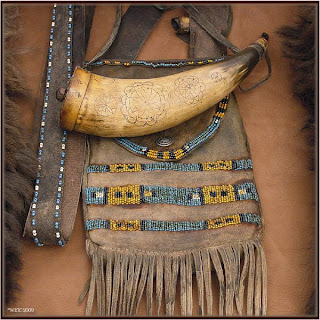


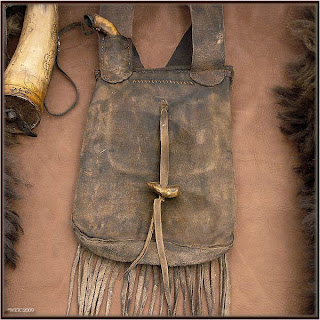

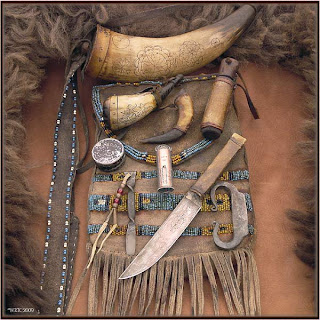




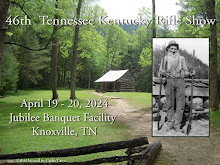

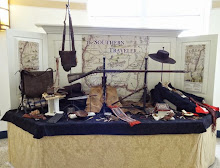





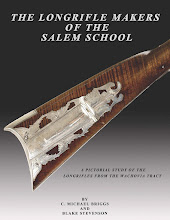

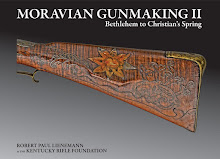


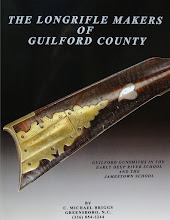

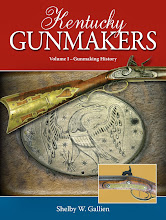









Terrific pieces and a compelling post overall! I especially enjoy how every part of the bags and accessories seems to have a story and connection to a particular time in your life, ie: "a long haired buddy of mine and I used to bet hair locks in our shooting contests" or "Hand Forged fire striker from a piece of old wagon spring found along the Oregon Trail near South Pass in 1973 or 74". Your work is full of character as well as technical expertise-- well done, and thanks for sharing!
ReplyDeleteThis is so inspiring..absolutely beautiful craftmanship. The stories are truly delightful..thank you so much..I learned alot and enjoyed it.
ReplyDelete